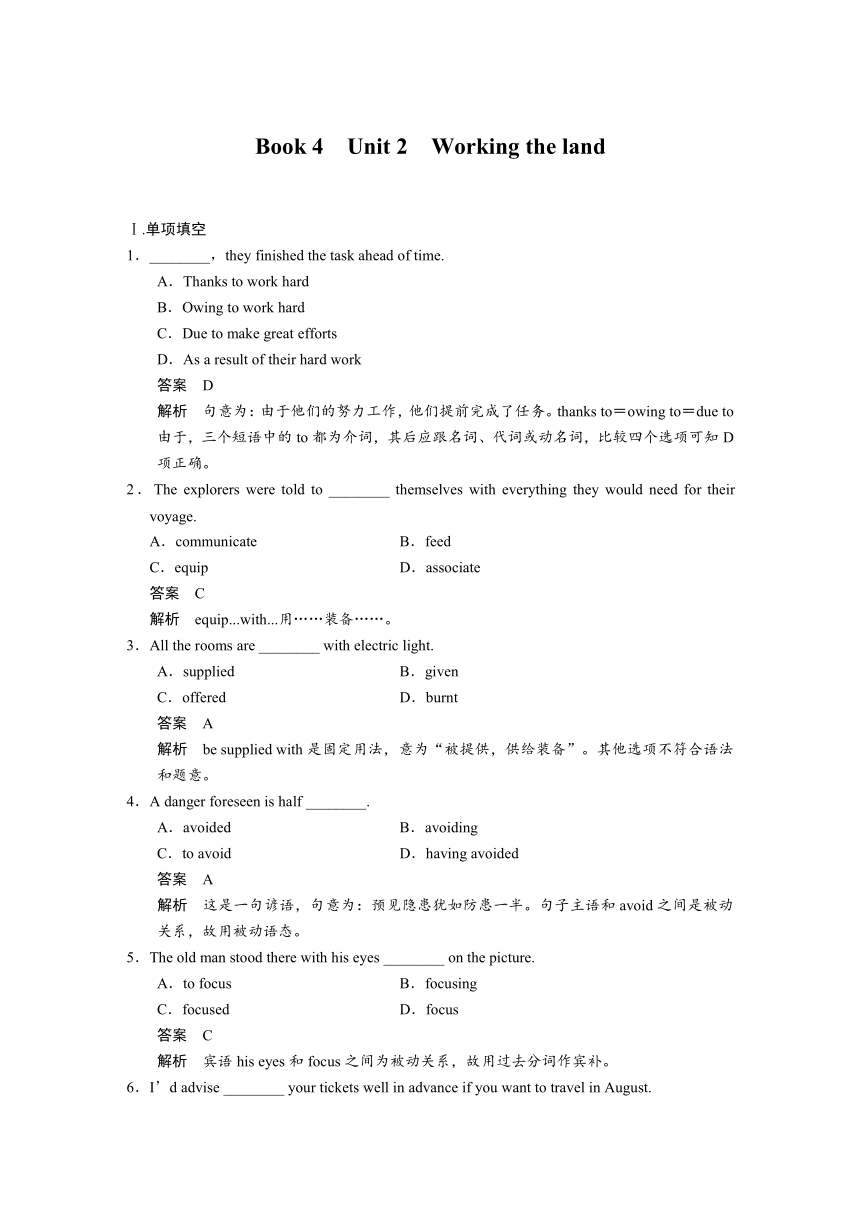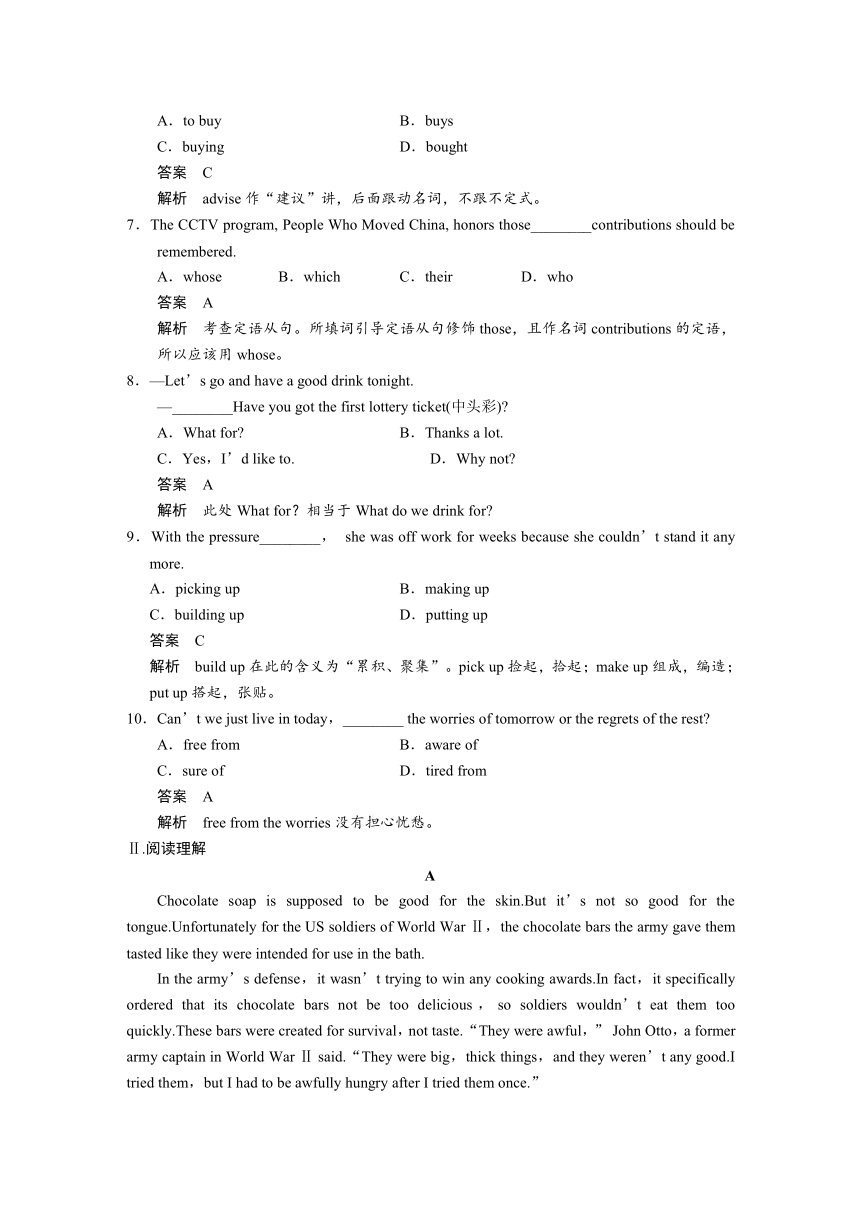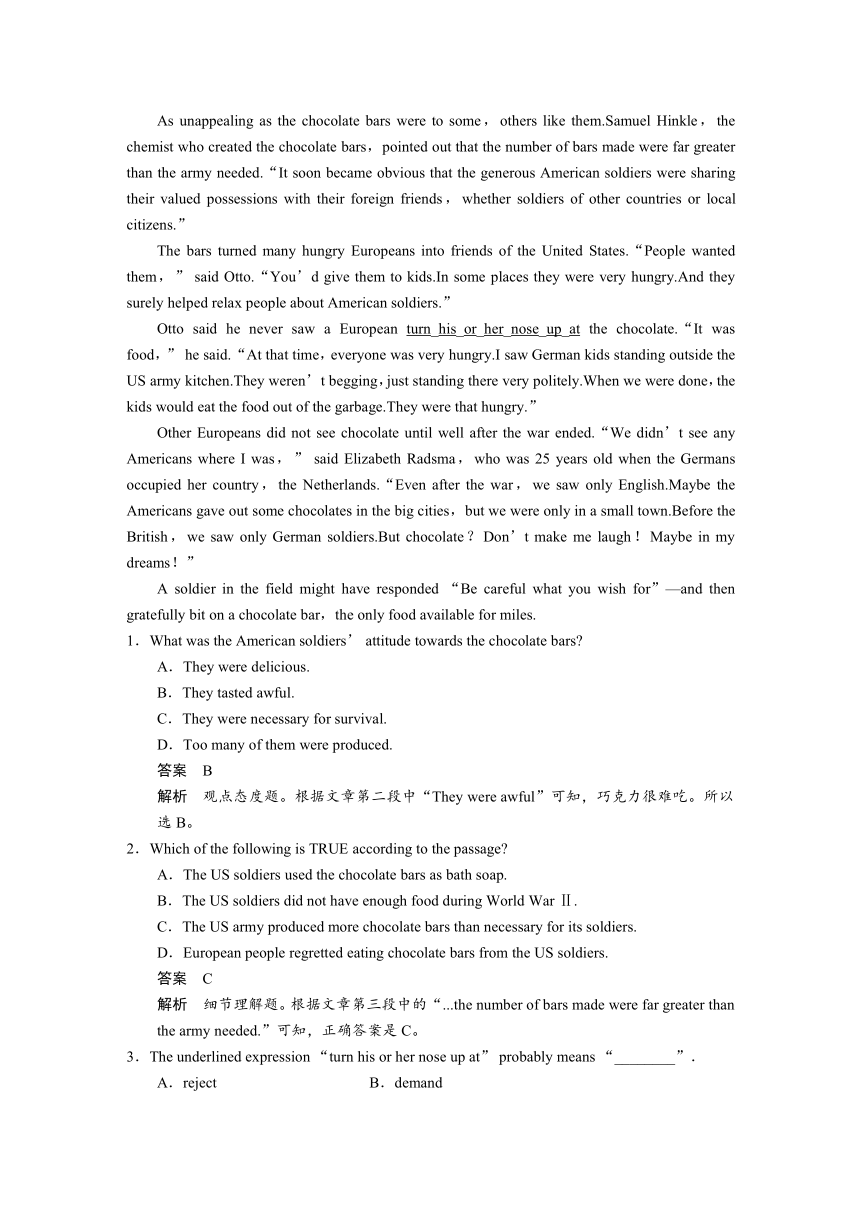大一轮高考英语练出高分人教版新课标必修4 Unit 2 Working the land
文档属性
| 名称 | 大一轮高考英语练出高分人教版新课标必修4 Unit 2 Working the land |  | |
| 格式 | zip | ||
| 文件大小 | 19.3KB | ||
| 资源类型 | 教案 | ||
| 版本资源 | 人教版(新课程标准) | ||
| 科目 | 英语 | ||
| 更新时间 | 2015-12-03 18:45:05 | ||
图片预览



文档简介
Book 4 Unit 2 Working the land
Ⅰ.单项填空
1.________,they finished the task ahead of time.
A.Thanks to work hard
B.Owing to work hard
C.Due to make great efforts
D.As a result of their hard work
答案 D
解析 句意为:由于他们的努力工作,他们提前完成了任务。thanks to=owing to=due to由于,三个短语中的to都为介词,其后应跟名词、代词或动名词,比较四个选项可知D项正确。
2.The explorers were told to ________ themselves with everything they would need for their voyage.
A.communicate B.feed
C.equip D.associate
答案 C
解析 equip...with...用……装备……。
3.All the rooms are ________ with electric light.
A.supplied B.given
C.offered D.burnt
答案 A
解析 be supplied with是固定用法,意为“被提供,供给装备”。其他选项不符合语法和题意。
4.A danger foreseen is half ________.
A.avoided B.avoiding
C.to avoid D.having avoided
答案 A
解析 这是一句谚语,句意为:预见隐患犹如防患一半。句子主语和avoid之间是被动关系,故用被动语态。
5.The old man stood there with his eyes ________ on the picture.
A.to focus B.focusing
C.focused D.focus
答案 C
解析 宾语his eyes和focus之间为被动关系,故用过去分词作宾补。
6.I’d advise ________ your tickets well in advance if you want to travel in August.
A.to buy B.buys
C.buying D.bought
答案 C
解析 advise作“建议”讲,后面跟动名词,不跟不定式。
7.The CCTV program, People Who Moved China, honors those________contributions should be remembered.
A.whose B.which C.their D.who
答案 A
解析 考查定语从句。所填词引导定语从句修饰those,且作名词contributions的定语,所以应该用whose。
8.—Let’s go and have a good drink tonight.
—________Have you got the first lottery ticket(中头彩)
A.What for B.Thanks a lot.
C.Yes,I’d like to. D.Why not
答案 A
解析 此处What for?相当于What do we drink for
9.With the pressure________, she was off work for weeks because she couldn’t stand it any more.
A.picking up B.making up
C.building up D.putting up
答案 C
解析 build up在此的含义为“累积、聚集”。pick up捡起,拾起;make up组成,编造;put up搭起,张贴。
10.Can’t we just live in today,________ the worries of tomorrow or the regrets of the rest
A.free from B.aware of
C.sure of D.tired from
答案 A
解析 free from the worries没有担心忧愁。
Ⅱ.阅读理解
A
Chocolate soap is supposed to be good for the skin.But it’s not so good for the tongue.Unfortunately for the US soldiers of World War Ⅱ,the chocolate bars the army gave them tasted like they were intended for use in the bath.
In the army’s defense,it wasn’t trying to win any cooking awards.In fact,it specifically ordered that its chocolate bars not be too delicious,so soldiers wouldn’t eat them too quickly.These bars were created for survival,not taste.“They were awful,” John Otto,a former army captain in World War Ⅱ said.“They were big,thick things,and they weren’t any good.I tried them,but I had to be awfully hungry after I tried them once.”
As unappealing as the chocolate bars were to some,others like them.Samuel Hinkle,the chemist who created the chocolate bars,pointed out that the number of bars made were far greater than the army needed.“It soon became obvious that the generous American soldiers were sharing their valued possessions with their foreign friends,whether soldiers of other countries or local citizens.”
The bars turned many hungry Europeans into friends of the United States.“People wanted them,” said Otto.“You’d give them to kids.In some places they were very hungry.And they surely helped relax people about American soldiers.”
Otto said he never saw a European turn_his_or_her_nose_up_at the chocolate.“It was food,” he said.“At that time,everyone was very hungry.I saw German kids standing outside the US army kitchen.They weren’t begging,just standing there very politely.When we were done,the kids would eat the food out of the garbage.They were that hungry.”
Other Europeans did not see chocolate until well after the war ended.“We didn’t see any Americans where I was,” said Elizabeth Radsma,who was 25 years old when the Germans occupied her country,the Netherlands.“Even after the war,we saw only English.Maybe the Americans gave out some chocolates in the big cities,but we were only in a small town.Before the British,we saw only German soldiers.But chocolate?Don’t make me laugh!Maybe in my dreams!”
A soldier in the field might have responded “Be careful what you wish for”—and then gratefully bit on a chocolate bar,the only food available for miles.
1.What was the American soldiers’ attitude towards the chocolate bars
A.They were delicious.
B.They tasted awful.
C.They were necessary for survival.
D.Too many of them were produced.
答案 B
解析 观点态度题。根据文章第二段中“They were awful”可知,巧克力很难吃。所以选B。
2.Which of the following is TRUE according to the passage
A.The US soldiers used the chocolate bars as bath soap.
B.The US soldiers did not have enough food during World War Ⅱ.
C.The US army produced more chocolate bars than necessary for its soldiers.
D.European people regretted eating chocolate bars from the US soldiers.
答案 C
解析 细节理解题。根据文章第三段中的“...the number of bars made were far greater than the army needed.”可知,正确答案是C。
3.The underlined expression “turn his or her nose up at” probably means “________”.
A.reject B.demand
C.receive D.smell
答案 A
解析 词义猜测题。根据该段后文的叙述可推知选A。
4.Why does the author mention the German kids’ story
A.To tell how friendly the American soldiers were.
B.To describe the hunger in Germany during the war.
C.To prove German kids could be very polite.
D.To show how much they were eager for chocolate.
答案 B
解析 推理判断题。根据第五段的内容可知,作者是为了描述战争期间德国人饥饿的状态。故选B。
5.Elizabeth Radsma never saw chocolate during the war because ________.
A.the US soldiers handed out all chocolates to people in big cities
B.the German soldiers kept them all for themselves
C.the British soldiers didn’t share it with the local people
D.the US soldiers never showed up in the small town she lived in
答案 D
解析 推理判断题。根据倒数第二段中的“Maybe the Americans gave out some chocolates in the big cities,but we were only in a small town.”可知选D。
B
Forty years ago,Finland was a small country with mediocre(平凡的) public schools.Today,Finland is still small but no one calls Finland’s public schools mediocre anymore.
In 2000,the Finns surprised the world when their 15 year olds scored at the top of a closely watched international exam called the PISA,the Program for International Student Assessment.Finland has stayed near the top ever since,while the US scores around the middle.
Pasi Sahlberg,an official of Finland’s Ministry of Education and Culture,is in Seattle this week to share the story of Finland’s success,and what states like Washington can learn from it.
Sahlberg’s message,although he is too polite to put it so bluntly:Stop testing so much.Trust teachers more.Give less homework.Shorten the school day.
On Tuesday,in a room filled with teachers,principals,professors,school board members and policy makers,Sahlberg joked about the Finns’ reputation for being a quiet,humble people.When Finland hit the top of the PISA,he said,the biggest disbelievers were Finns.
More seriously,he said,Finland never set out to create the world’s top school system.Instead,he said,the country decided in the 1970s that it wanted to ensure that a student’s success didn’t depend on family background.
To achieve that goal,Finland relied on cooperation among teachers and schools,rather than on competition.
Rather than judging teachers and schools based on test scores,he said,Finland puts trust in its teachers and principals.Teachers develop the curriculum in Finland,and design their own tests.There are no national tests,except one at the end of high school.
That’s just the start.Along with a shorter school day,Finnish students don’t even start school until they are 7 years old.Many primary schools have a policy against giving homework.
But Finland,he said,succeeded in part by adapting ideas from the US and other countries.And those countries,he said,can learn from Finland,too.
6.What might be the author’s purpose in writing the passage
A.To introduce a Finnish official.
B.To compare the education systems of Finland and the US.
C.To share the story of Finland’s success in education.
D.To ask the US to improve its education.
答案 C
解析 写作目的题。综合分析全文可知,作者以芬兰教育文化部官员的报告为切入点介绍了芬兰教育成功的秘密,故C项正确。
7.People first learned Finland’s success in education from ________.
A.its students’ performance in an International exam
B.its international exchange students
C.lectures given by Pasi Sahlberg
D.its mediocre public schools
答案 A
解析 细节理解题。由文章第二段可知,在2000年,芬兰学生在一个国际学生评估项目中拔得头筹,由此人们开始了解芬兰在教育方面取得的成功。故选A项。
8.Which of the following contributes to Finland’s success in education
a.Giving students less test.
b.Giving teachers more trust.
c.Evaluating students’ family background.
d.Creating the world’s top school system.
e.Starting school late.
A.a,b,c B.c,d,e
C.a,b,e D.b,c,d
答案 C
解析 细节理解题。综合第四段、第六段及倒数第二段所给的信息可知,芬兰的教育成功之处在于:减少考试,相信老师,上学晚等,而c、d两项不是芬兰所提倡的,故C项正确。
9.Students in Finland are given a national test ________.
A.at the end of every term
B.before graduating from high school
C.before they enter high school
D.before graduating from the college
答案 B
解析 细节理解题。由文章倒数第三段最后一句“There are no national tests,except one at the end of high school.”可知,芬兰的学生只有高中毕业时才参加一次全国考试,故B项正确。
10.What Pasi Sahlberg says in the passage suggests that ________.
A.children should start school as early as possible
B.competition among teachers is harmful to education
C.the US education system is still the most advanced
D.it’s necessary to set up a national curriculum
答案 B
解析 推理判断题。由文章倒数第四段可知,芬兰的教育注重老师和学校之间的合作,而不是竞争,由此推断B项正确。
Ⅲ.写作素材(关于发展)
提示:黑体部分用本单元词汇表达,并且请使用which引导的定语从句,过去分词短语作状语等。
1.在这个地区饥饿曾是个困扰人的问题,导致很多人死亡。
Hunger,which used to be disturbing in this area,led to a lot of deaths.
2.在过去的十年里,多亏了政府的帮助,农民们成功地抵制了土地的沙漠化。
In the past decade,thanks to the government’s help,farmers have succeeded in the struggle against the expanding desert.
3.有了新的农耕技术,农民们的谷物和其他粮食的产量都增加了。
Equipped with new farming methods,farmers’ output of grain and other crops has increased.
4.人们满足于目前的生活。
People are satisfied with their present life.
Ⅰ.单项填空
1.________,they finished the task ahead of time.
A.Thanks to work hard
B.Owing to work hard
C.Due to make great efforts
D.As a result of their hard work
答案 D
解析 句意为:由于他们的努力工作,他们提前完成了任务。thanks to=owing to=due to由于,三个短语中的to都为介词,其后应跟名词、代词或动名词,比较四个选项可知D项正确。
2.The explorers were told to ________ themselves with everything they would need for their voyage.
A.communicate B.feed
C.equip D.associate
答案 C
解析 equip...with...用……装备……。
3.All the rooms are ________ with electric light.
A.supplied B.given
C.offered D.burnt
答案 A
解析 be supplied with是固定用法,意为“被提供,供给装备”。其他选项不符合语法和题意。
4.A danger foreseen is half ________.
A.avoided B.avoiding
C.to avoid D.having avoided
答案 A
解析 这是一句谚语,句意为:预见隐患犹如防患一半。句子主语和avoid之间是被动关系,故用被动语态。
5.The old man stood there with his eyes ________ on the picture.
A.to focus B.focusing
C.focused D.focus
答案 C
解析 宾语his eyes和focus之间为被动关系,故用过去分词作宾补。
6.I’d advise ________ your tickets well in advance if you want to travel in August.
A.to buy B.buys
C.buying D.bought
答案 C
解析 advise作“建议”讲,后面跟动名词,不跟不定式。
7.The CCTV program, People Who Moved China, honors those________contributions should be remembered.
A.whose B.which C.their D.who
答案 A
解析 考查定语从句。所填词引导定语从句修饰those,且作名词contributions的定语,所以应该用whose。
8.—Let’s go and have a good drink tonight.
—________Have you got the first lottery ticket(中头彩)
A.What for B.Thanks a lot.
C.Yes,I’d like to. D.Why not
答案 A
解析 此处What for?相当于What do we drink for
9.With the pressure________, she was off work for weeks because she couldn’t stand it any more.
A.picking up B.making up
C.building up D.putting up
答案 C
解析 build up在此的含义为“累积、聚集”。pick up捡起,拾起;make up组成,编造;put up搭起,张贴。
10.Can’t we just live in today,________ the worries of tomorrow or the regrets of the rest
A.free from B.aware of
C.sure of D.tired from
答案 A
解析 free from the worries没有担心忧愁。
Ⅱ.阅读理解
A
Chocolate soap is supposed to be good for the skin.But it’s not so good for the tongue.Unfortunately for the US soldiers of World War Ⅱ,the chocolate bars the army gave them tasted like they were intended for use in the bath.
In the army’s defense,it wasn’t trying to win any cooking awards.In fact,it specifically ordered that its chocolate bars not be too delicious,so soldiers wouldn’t eat them too quickly.These bars were created for survival,not taste.“They were awful,” John Otto,a former army captain in World War Ⅱ said.“They were big,thick things,and they weren’t any good.I tried them,but I had to be awfully hungry after I tried them once.”
As unappealing as the chocolate bars were to some,others like them.Samuel Hinkle,the chemist who created the chocolate bars,pointed out that the number of bars made were far greater than the army needed.“It soon became obvious that the generous American soldiers were sharing their valued possessions with their foreign friends,whether soldiers of other countries or local citizens.”
The bars turned many hungry Europeans into friends of the United States.“People wanted them,” said Otto.“You’d give them to kids.In some places they were very hungry.And they surely helped relax people about American soldiers.”
Otto said he never saw a European turn_his_or_her_nose_up_at the chocolate.“It was food,” he said.“At that time,everyone was very hungry.I saw German kids standing outside the US army kitchen.They weren’t begging,just standing there very politely.When we were done,the kids would eat the food out of the garbage.They were that hungry.”
Other Europeans did not see chocolate until well after the war ended.“We didn’t see any Americans where I was,” said Elizabeth Radsma,who was 25 years old when the Germans occupied her country,the Netherlands.“Even after the war,we saw only English.Maybe the Americans gave out some chocolates in the big cities,but we were only in a small town.Before the British,we saw only German soldiers.But chocolate?Don’t make me laugh!Maybe in my dreams!”
A soldier in the field might have responded “Be careful what you wish for”—and then gratefully bit on a chocolate bar,the only food available for miles.
1.What was the American soldiers’ attitude towards the chocolate bars
A.They were delicious.
B.They tasted awful.
C.They were necessary for survival.
D.Too many of them were produced.
答案 B
解析 观点态度题。根据文章第二段中“They were awful”可知,巧克力很难吃。所以选B。
2.Which of the following is TRUE according to the passage
A.The US soldiers used the chocolate bars as bath soap.
B.The US soldiers did not have enough food during World War Ⅱ.
C.The US army produced more chocolate bars than necessary for its soldiers.
D.European people regretted eating chocolate bars from the US soldiers.
答案 C
解析 细节理解题。根据文章第三段中的“...the number of bars made were far greater than the army needed.”可知,正确答案是C。
3.The underlined expression “turn his or her nose up at” probably means “________”.
A.reject B.demand
C.receive D.smell
答案 A
解析 词义猜测题。根据该段后文的叙述可推知选A。
4.Why does the author mention the German kids’ story
A.To tell how friendly the American soldiers were.
B.To describe the hunger in Germany during the war.
C.To prove German kids could be very polite.
D.To show how much they were eager for chocolate.
答案 B
解析 推理判断题。根据第五段的内容可知,作者是为了描述战争期间德国人饥饿的状态。故选B。
5.Elizabeth Radsma never saw chocolate during the war because ________.
A.the US soldiers handed out all chocolates to people in big cities
B.the German soldiers kept them all for themselves
C.the British soldiers didn’t share it with the local people
D.the US soldiers never showed up in the small town she lived in
答案 D
解析 推理判断题。根据倒数第二段中的“Maybe the Americans gave out some chocolates in the big cities,but we were only in a small town.”可知选D。
B
Forty years ago,Finland was a small country with mediocre(平凡的) public schools.Today,Finland is still small but no one calls Finland’s public schools mediocre anymore.
In 2000,the Finns surprised the world when their 15 year olds scored at the top of a closely watched international exam called the PISA,the Program for International Student Assessment.Finland has stayed near the top ever since,while the US scores around the middle.
Pasi Sahlberg,an official of Finland’s Ministry of Education and Culture,is in Seattle this week to share the story of Finland’s success,and what states like Washington can learn from it.
Sahlberg’s message,although he is too polite to put it so bluntly:Stop testing so much.Trust teachers more.Give less homework.Shorten the school day.
On Tuesday,in a room filled with teachers,principals,professors,school board members and policy makers,Sahlberg joked about the Finns’ reputation for being a quiet,humble people.When Finland hit the top of the PISA,he said,the biggest disbelievers were Finns.
More seriously,he said,Finland never set out to create the world’s top school system.Instead,he said,the country decided in the 1970s that it wanted to ensure that a student’s success didn’t depend on family background.
To achieve that goal,Finland relied on cooperation among teachers and schools,rather than on competition.
Rather than judging teachers and schools based on test scores,he said,Finland puts trust in its teachers and principals.Teachers develop the curriculum in Finland,and design their own tests.There are no national tests,except one at the end of high school.
That’s just the start.Along with a shorter school day,Finnish students don’t even start school until they are 7 years old.Many primary schools have a policy against giving homework.
But Finland,he said,succeeded in part by adapting ideas from the US and other countries.And those countries,he said,can learn from Finland,too.
6.What might be the author’s purpose in writing the passage
A.To introduce a Finnish official.
B.To compare the education systems of Finland and the US.
C.To share the story of Finland’s success in education.
D.To ask the US to improve its education.
答案 C
解析 写作目的题。综合分析全文可知,作者以芬兰教育文化部官员的报告为切入点介绍了芬兰教育成功的秘密,故C项正确。
7.People first learned Finland’s success in education from ________.
A.its students’ performance in an International exam
B.its international exchange students
C.lectures given by Pasi Sahlberg
D.its mediocre public schools
答案 A
解析 细节理解题。由文章第二段可知,在2000年,芬兰学生在一个国际学生评估项目中拔得头筹,由此人们开始了解芬兰在教育方面取得的成功。故选A项。
8.Which of the following contributes to Finland’s success in education
a.Giving students less test.
b.Giving teachers more trust.
c.Evaluating students’ family background.
d.Creating the world’s top school system.
e.Starting school late.
A.a,b,c B.c,d,e
C.a,b,e D.b,c,d
答案 C
解析 细节理解题。综合第四段、第六段及倒数第二段所给的信息可知,芬兰的教育成功之处在于:减少考试,相信老师,上学晚等,而c、d两项不是芬兰所提倡的,故C项正确。
9.Students in Finland are given a national test ________.
A.at the end of every term
B.before graduating from high school
C.before they enter high school
D.before graduating from the college
答案 B
解析 细节理解题。由文章倒数第三段最后一句“There are no national tests,except one at the end of high school.”可知,芬兰的学生只有高中毕业时才参加一次全国考试,故B项正确。
10.What Pasi Sahlberg says in the passage suggests that ________.
A.children should start school as early as possible
B.competition among teachers is harmful to education
C.the US education system is still the most advanced
D.it’s necessary to set up a national curriculum
答案 B
解析 推理判断题。由文章倒数第四段可知,芬兰的教育注重老师和学校之间的合作,而不是竞争,由此推断B项正确。
Ⅲ.写作素材(关于发展)
提示:黑体部分用本单元词汇表达,并且请使用which引导的定语从句,过去分词短语作状语等。
1.在这个地区饥饿曾是个困扰人的问题,导致很多人死亡。
Hunger,which used to be disturbing in this area,led to a lot of deaths.
2.在过去的十年里,多亏了政府的帮助,农民们成功地抵制了土地的沙漠化。
In the past decade,thanks to the government’s help,farmers have succeeded in the struggle against the expanding desert.
3.有了新的农耕技术,农民们的谷物和其他粮食的产量都增加了。
Equipped with new farming methods,farmers’ output of grain and other crops has increased.
4.人们满足于目前的生活。
People are satisfied with their present life.
同课章节目录
